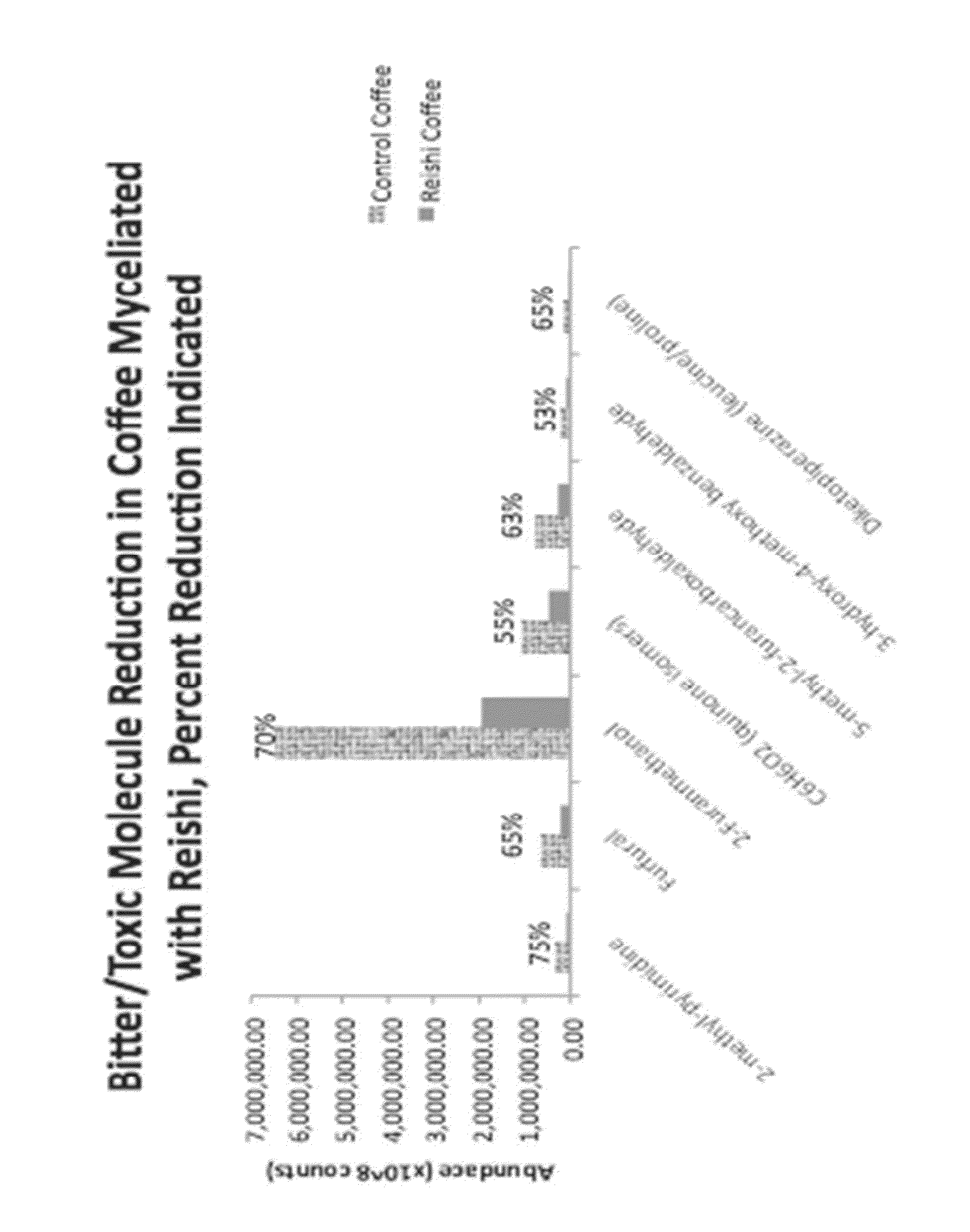Myceliated Coffee Products and Methods for Making Myceliated Coffee Products
a technology of myceliated coffee and products, applied in coffee, green coffee treatment, food science, etc., can solve the problems of little improvement in nutritional value, and achieve the effects of reducing cost, increasing value of poorer quality coffee, and reducing the cos
- Summary
- Abstract
- Description
- Claims
- Application Information
AI Technical Summary
Benefits of technology
Problems solved by technology
Method used
Image
Examples
example 1
[0114]2½ gallon ball-jars were obtained, cleaned, and dried. The lids were outfitted such as to allow for gaseous diffusion into and out of the jars, and with tin-foil collars. The jars were half-filled with provided dried Arabica green coffee beans. Water was added to the jars so as to just cover the beans, and the beans soaked for 2 hours, at which point the water was decanted. The moisture content of the beans was estimated to be 30%. The jars were placed into 41 quart pressure-cookers in a clean-room and sterilized at 15 lb / in2 for 90 minutes, and were then removed immediately into a sterile laminar flow hood to cool. Once cool, the jars of prepared green coffee beans were inoculated with whole Petri plate cultures of G. lucidum and C. sinensis, each culture into a separate jar. The cultures had been grown on an organic food medium comprising 40% (v / v) organic potato extract, 20% (v / v) organic carrot extract, 5 g / L organic ground celery, and 17 g / L agar for 12 days, having been ...
example 2
[0115]8, 1 gallon ball jars were obtained, cleaned, and dried. The lids were outfitted such as to allow for gaseous diffusion into and out of the jars, and with tin-foil collars. The jars were half-filled with provided dried Robusta green coffee beans. Water was added to the jars so as to just cover the beans, and the beans soaked for 2.5 hours, at which point the water was decanted. The moisture content of the beans was estimated to be 33%. The jars were placed into 41 quart pressure-cookers in a clean-room and sterilized at 15 lb / in2 for 90 minutes, and were then removed immediately into a sterile laminar flow hood to cool. Once cool, the jars of prepared green coffee beans were inoculated with floating liquid tissue cultures of M. angusticeps, T. versicolor, H. erinaceus, V. volvacea, P. nameko, F. velutipes, and I. obliquus. The entire pancake of the floating cultures and approximately half of their liquid contents were added to the jars. The floating liquid tissue cultures were...
example 3
[0116]18 provided 2.2 mm polypropylene bags of dimensions 5″×8″×19″ (width×depth×height) were each filled with 2.9 kg of dried, provided Robusta green coffee beans at an initial moisture content of 8.6%. 1.52 L of RO water was added to each bag, and the bags were wrapped around the water / green coffee bean mass so as not to invert or tilt the bags. The bags were then loosely wrapped with EPDM bands to hold the shape of the wrap. The 16 prepared bags were placed into an autoclave and sterilized for 140 minutes at 22 lb / in2. Once sterilized, the bags were placed into a clean-space to cool. Once cool, the weight of the bags indicated that the moisture content of the beans had been raised to 40%. The bags were inoculated with submerged liquid tissue cultures of Hericium erinaceus, Pleurotus ostreatus, Trametes versicolor, Lentinula edodes, Tricholoma matsutake, Flammulina velutipes, Volvariella volvacea, Agaricus blazei, Grifola frondosa, Pholiota nameko, Ganoderma lucidum, Ganoderma app...
PUM
 Login to View More
Login to View More Abstract
Description
Claims
Application Information
 Login to View More
Login to View More - R&D
- Intellectual Property
- Life Sciences
- Materials
- Tech Scout
- Unparalleled Data Quality
- Higher Quality Content
- 60% Fewer Hallucinations
Browse by: Latest US Patents, China's latest patents, Technical Efficacy Thesaurus, Application Domain, Technology Topic, Popular Technical Reports.
© 2025 PatSnap. All rights reserved.Legal|Privacy policy|Modern Slavery Act Transparency Statement|Sitemap|About US| Contact US: help@patsnap.com


